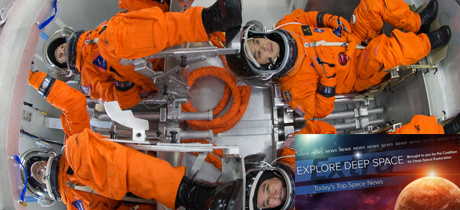In Today’s Deep Space Extra… Orion spacesuits tested at NASA Johnson Space Center.
Human Space Exploration
Orion spacesuits put to a vacuum test at NASA
Space.com (7/18): At NASA’s Johnson Space Center, engineers test an advanced version of the agency’s space shuttle space suit for use by astronauts assigned to flights aboard the Orion crew exploration capsule. Engineers shared photos as the suits were exposed to a vacuum.
VASIMR plasma engine: Earth to Mars in 39 days?
Spaceflight Insider (7/19): Ad Astra Rocket Co. is at work on an in space plasma rocket engine, the Variable Specific Impulse Magnetoplasma Rocket, that could accelerate what is now a month’s long journey to Mars using conventional chemical rocket engines. Advanced work at Ad Astra is funded under a 2015 NASA contract. The VASIMR power source to heat a range of fuels to a plasma state could be solar or nuclear, the high temperature plasma is contained and channeled as exhaust by a magnetic field.
Space tourist from Asian country to travel to ISS in 2019
Sputnik News of Russia (7/19): The regular launch of space tourists to the International Space Tourists will resume in 2019, according to an executive with Rocket Space Corporation Energia, of Russia.
Space Science
This is one of the largest structures we know of in the universe
Universe Today (7/18): Indian astronomers describe perhaps the largest known Supercluster, or collection of galaxy clusters. Saraswati is 650 million light years across. In comparison the Milky Way stretches 100,000 to 180,000 light years across. Findings were published in the Astrophysical Journal.
LISA Pathfinder: Time called on Europe’s gravity probe
BBC of Britain (7/18): Launched in 2015, the European Space Agency’s LISA Pathfinder mission has proved a concept, the presence of gravity waves predicted by Einstein’s Theory of General Relativity. Gravity waves are ripples in space time. ESA plans a follow on investigation involving three satellites set for launching between 2030 and 2034.
Other News
Measuring cyclones from space has global benefits
R & D Magazine (7/18): Researchers may look to the sky to better predict the devastating hurricanes and typhoons that take place around the globe every year. At a panel on the Benefits for Humanity-Innovations on the International Space Station (ISS) during the ISS R&D Conference 2017, Paul Joss, a professor of physics at the Massachusetts Institute of Technology, said by viewing cyclones at 400 km above sea level, researchers will be able to better predict their ultimate impact on human life.

